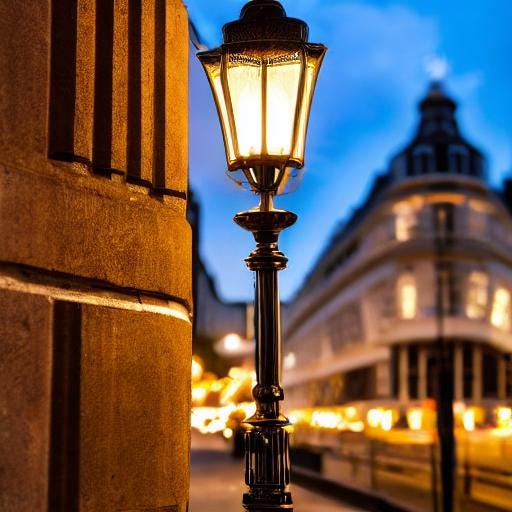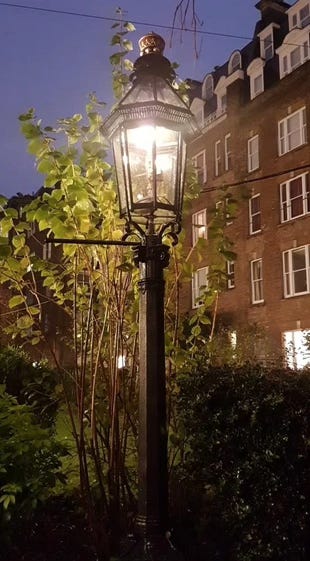Along with rolling banks of impenetrable fog and the clopping of hooves down cobbled streets, the myopic glow of gaslights is one of the indelible romantic images to come to mind when one thinks of Victorian London. These precursors to modern incandescent streetlights were amongst the great metropolis’s first sentinels in the fight against the unforgiving darkness that came with the night. Modern city living makes it easy to forget just how opaque night can be, especially if it’s a moonless one, or one enshrouded by cloud and fog. In the early 19th Century, even the streets of a city as populated as London became as unnavigable as a dense wood after nightfall. This made its many lanes and warrens a dreaded hunting ground for the worst of criminals, and anyone who dared to wander out was at risk of being assaulted, robbed, or worse.
It was the wealthier classes of the West End who first tackled the problem of lighting the streets, largely because they were able to afford a solution. While oil lamps came into use in the 18th Century, they were sparse and needed constant refuelling, but they were popular amongst the public for the illumination they provided and sparked a push for a better system. The first known gas lamp was posted on a wall dividing St. James’s Park along Pall Mall as part of the celebrations for King George III’s birthday in 1807. German-born inventor Frederick Winsor developed and demonstrated the lamp and went on to establish his own coal-and-gas company, and lamps began popping up along London streets by 1812. By 1823, he was providing the fuel for 40,000 gas lamps. This number would more than double as the century progressed, and in its peak hundreds of miles of London’s streets flickered under the soft glow of gaslight, making it the envy of the developing world which trailed behind in the literal dark.
Initially, gaslights were lit by a municipal lamplighter, a caped-and-hatted man who walked about the streets before dusk with an 8-foot brass pole in hand. The tip of the pole danced with the small flame of a pilot light, which the lamplighter would lay against the mantle of the lamp to ignite the gas within. It would then burn all night. In the morning, the lamplighter would return to extinguish the flame. Other roles might include cleaning the mantles to ensure they burned well and polishing the glass of the lamp coverings to keep them bright. At their peak, 25,000 lamplighters serviced the gaslights of London daily. But the occupation dimmed as the century went on, giving way to mechanical wind-up timers and, eventually, electric lights. Just five lamplighters continue to work in London today.
As the prevalence of gaslighting waned into the Twentieth Century, London still maintained many thousands of lamps into the mid-1940’s until German bomb damage prompted urban redevelopments in the decades that followed. Few gas lamps remained by the 1960’s and even then, they were mostly maintained for their aesthetic value as opposed to any practical use. But more on that in a moment.
So, how bright were gas lamps? The short answer: not very. Some have equated the illumination to that of a 40-watt refrigerator bulb. That’s about enough to radiate a shallow pool of yellowish light downward over the immediate patch of surrounding pavement while going little further. This was better than nothing, and in the well-to-do neighbourhoods the frequency of lamps was far higher, leaving fewer dark shadows between them. In the poorer districts, such as the East End, the presence of lamps was far sparer, with many side streets and courts having one or none. Their upkeep was not guaranteed either, meaning many did not function properly or at all. Some private businesses, such as pubs, lodging houses, and apartment tenements, might be the only source of light for entire streets as they often had lamps fired-up over their entrances and inside their windows. However, they burned at the proprietor’s expense, so it was not uncommon for these lights to be extinguished by 11 pm. This left the more squalid quarters of London vulnerable to nocturnal human predators who haunted and hunted the streets under the shroud of nightfall. Even Queen Victoria, in a November 1888 letter responding to the Jack the Ripper murders around Whitechapel and Spitalfields, stated that “All these courts must be lit…,” indicating an awareness that darkness often begets violence. But poverty begets neglect and even the Queen’s advice was not immediately acted on. This left much of the East End’s disregarded denizens veiled in shadow until major slum clearance and development began in the 1920’s.
Of course, London is very well lit today, with all of its streets and homes and shops ablaze from dusk to dawn with the glare of electric lighting. That does not mean that the enchanting glow of gaslights has been snuffed out permanently though. Up until recently, there were about 1500 active gas lamps still burning around London. Just as they originally lit up the West End two centuries ago, those that still exist largely remain in the West End with a few exceptions. As stated earlier, this is an aesthetic choice meant to keep alive the magic of an era long gone. But the push is on to reduce the number of gas lamps, with critics citing environmental concerns and soaring costs as reasons to turn the old gas-jets into modern LED simulations. Those lamps that have so far been replaced (and there have been hundreds already) retain the look of the original Victorian lamp posts, with the LEDs adjusted to reflect the colour and ambience of bygone gaslights.
It’s still possible to view London by gaslight. Many are found around tourist areas such as Covent Garden, specifically in St. Paul’s Graveyard where ten lamps continue to burn. In Westminster the local council has waged war to convert the remaining 300 lamps in its district, but the narrow, shop-lined thoroughfares of Cecil Street and Goodwin Court retain their gas lamps, as do the gates outside of Whitehall, Buckingham Palace, and other more posh and historic landmarks. Even the East End preserves at least two quarters where gas is on display. This includes Malam Gardens, a small group of rowhouses in Poplar built to provide homes for coal workers in the 1930’s. Five gas lamps were erected in that development, and continue to burn today, but their existence is likely limited. Another notable lamp is mounted over the doorway of the Dennis Severs’ House at 18 Folgate Street in Spitalfields. This interesting Georgian terrace dates to the 18th Century, and its interior was restored by a wealthy American in the 1980’s to reflect the lifestyle of the early silk weavers that once inhabited the area. The house and its history are worthy of their own article, but the lamp that burns brightly upon its façade is well worth passing while on an evening stroll (see video below).
When I next return to London, I hope to document and map out some of these existing sites and provide a sort of photographic walking guide for a future article. There are, of course, already plenty of online resources that map out gaslight-themed walks around central London. Some of the suggested walking tours my research turned up include: London Walks’ Old Westminster by Gaslight (https://www.walks.com/our-walks/old-westminster-by-gaslight-ok-try-to-top-this/) and Elan Walks’ Westminster by Gaslight (https://elanwalks.com/walks-available/). There are also plenty of resources and maps found through Google that will allow the intrepid explorer to design their own casual stroll through gaslit London.
One of the more notable lamps that stands out in these guides is on Carting Lane near Covent Garden, and is named the Patent Sewer Ventilating Lamp. This fixture was a by-product of the Great Stink crisis of 1858, wherein London became bogged down by its own stench due to improper sanitation. In response, engineer Sir Joseph Bazalgette designed what remains one of the most enviable human achievements in civilised history: the London sewer system, which cleaned the city and the Thames of human effluence and vastly improved the health of the metropolis. The early network did not allow for proper ventilation of gases which built up to dangerous levels in the confined tunnels of the sewer, leading to simple venting holes being drilled in key spots. This only created the problem of horrific odours escaping into homes and businesses. So, to remove the odours and not waste this useful by-product of human waste, an inventor named Joseph Webb posted methane-fuelled lamps over the vents, lighting the streets by burning off the otherwise harmful gas. While a wonderful idea, their illumination was quite weak, and improvements were made by mixing the methane with coal-fuelled gas. Eventually, upgrades to the sewer network and other advancements made the lamps obsolete, and the Carting Lane “Sewer Gas Destructor Lamp” as it is otherwise known remains the only one operating today.

While rolling fogs and clopping hooves were familiar to the landscape of Victorian London, they are now a rare romantic experience for the visitor to modern London. Gaslights still burn and can be enjoyed, but their existence, too, is threatened by the demands of an evolving world, and every year fewer of them light up the streets of London after dark. There is a popular push to keep them lit, and to keep the dying flames of bygone London ignited for the next generation.
Sources:
Thumbnail photo provided courtesy of BBC.com.
Guiberteau, Oliver. “London’s Last Gas Lamps – Exploring A Remainder of London’s Past.” Article: LondonXLondon.com. 9 January 2023. https://www.londonxlondon.com/london-gas-lamps/
Barnaby, Juliana. “Have you spotted London’s sewer gas destructor lamp?” Article: LondonXLonodn.com. 24 July 2020. https://www.londonxlondon.com/sewer-gas-lamp/
Wikipedia. Entry: “Lamplighter.” https://en.wikipedia.org/wiki/Lamplighter
Cheshire, James and Ollie O’Brien. “Mapping London: Lamplighters’ Map.” Website: Mapping London. https://mappinglondon.co.uk/2016/lamplighters-map/
Homepage for the Dennis Severs’ House: https://dennissevershouse.co.uk/about/the-house
Website: Heritage of London Trust: St Paul’s Gas Lamps: https://www.heritageoflondon.org/projects/st-paul%27s-gas-lamps
Lawton, Katherine. “Battle to save the last of the Westminster gas lamps: How the fight continues to stop dozens of iconic London streetlights being replaced with modern LED alternatives.” Article: The Daily Mail. 2 January 2024. https://www.dailymail.co.uk/news/article-12844989/Battle-save-Westminster-gas-lamps-fight-continues-stop-dozens-iconic-London-streetlights-replaced-modern-LED-alternatives.html
Evans, Stewart P. and Keith Skinner. The Ultimate Jack the Ripper Sourcebook: An Illustrated Encyclopedia. Robson Publishing, 2000.





